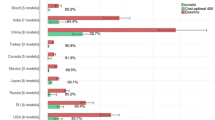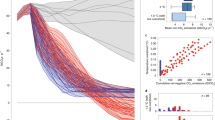Abstract
This study compares emission pathways aimed at limiting temperature increase to 2°C under varying constraints. In a first set of pathways, the timing of emission reductions is such that over the 2010–2100 period, assuming full participation from 2013 onwards, mitigation costs are minimized. In a second set of pathways, we set emissions in 2020 at a level based on the pledges of the Copenhagen Accord. In the ‘Copenhagen Potential’ scenario, climate talks result in satisfying conditions linked by countries to their ‘most ambitious’ proposals. Contrasting, in the ‘Copenhagen Current’ scenario, climate talks fall short of satisfying the conditions to move beyond current unilateral pledges. We include scenarios with and without the availability of bio-energy in combination with carbon capture and storage. We find that for a ‘Copenhagen Potential’ scenario, emissions by 2020 are higher (47 GtCO2eq/yr) than for a least-cost pathway for 2°C (43 GtCO2eq/yr with a 40–46 GtCO2eq/yr literature range). In the ‘Copenhagen Potential’ scenario the 2°C target can still be met with a likely chance, although discounted mitigation costs over 2010–2100 could be 10 to 15 % higher, and up to 60 % in the 2040–2050s, than for least-cost pathways. For the ‘Current Copenhagen’ scenario, maintaining an equally low probability of exceeding 2°C becomes infeasible in our model, implying higher costs due to higher climate risks. We conclude that there is some flexibility in terms of 2020 emissions compared to the optimal pathways but this is limited. The 2020 emission level represents a trade-off between short-term emission reductions and long-term dependence on rapid reductions through specific technologies (like negative emission reductions). Higher 2020 emissions lead to higher overall costs and reduced long-term flexibility, both leading to a higher risk of failing to hold warming below 2°C.



Similar content being viewed by others
Notes
Framework to Assess International Regimes for the differentiation of commitments—Simple Model for Climate Policy Assessment
Emissions in this paper refer to the sum of the six Kyoto greenhouse gas emissions (CO2 equivalent emissions weighted by global warming potentials as presented in the IPCC Fourth Assesment Report (Solomon et al. 2007)) as listed in Annex A of the Kyoto Protocol and include land-use related CO2 emissions
An annual reduction rate of 3.5–4.5 % of 2000 emission levels, applied to Kyoto greenhouse gases excluding land use CO2, for respectively with and without bio-energy with CCS (BECCS) technology. The potential reduction rate with BECCS is higher because this technology results in net negative emissions, as it replaces fossil fuels with biomass and captures and stores the CO2 from combustion.
The Joint Research Centre of the European Commission in Ispra, Italy, has calculated the estimated credits accounting for land use and forestry for all Annex I countries, as described in den Elzen et al. (2011), which would result in additional emission allowances of 2.5 % of 1990 Annex I emissions (about 0.5 GtCO2eq) by 2020.
A scenario is considered feasible if there is sufficient mitigation potential available to meet the climate target at all times during the evaluation period, at carbon prices below 1000$/tC.
Note that our reported total emissions comprise all GHG emissions of gases controlled under the Kyoto Protocol, and Ozon Depleting Substances (ODS) emissions are dealt with separately in our climate model. Total emission levels reported in Montzka et al. (2011) include ODS controlled under the Montreal Protocol, and higher CO2 emissions from land use. This explains about 3 Gt CO2eq of the difference.
Note that our estimates—in contrast with the UNEP figures—are based on non-harmonized historical data. With harmonization, the optimal emission level would be about 1 GtCO2eq higher by 2020 (also see SI)
References
Azar C, Lindgren K, Obersteiner M et al (2010) The feasibility of low CO2 concentration targets and the role of bio-energy with carbon capture and storage (BECCS). Clim Chang 100(1):195–202
Bouwman AF, Kram T, Klein-Goldewijk K (2006) Integrated modelling of global environmental change. An overview of IMAGE 2.4. Bilthoven, The Netherlands, Netherlands Environmental Assessment Agency
Clarke L, Edmonds J, Krey V et al (2009) International climate policy architectures: Overview of the EMF 22 International Scenarios. Energy Econ 31(SUPPL. 2):S64–S81
den Elzen MGJ, Van Vuuren DP (2007) Peaking profiles for achieving long-term temperature targets with more likelihood at lower costs. Proc Natl Acad Sci U S A 104(46):17931–17936
den Elzen M, Meinshausen M, van Vuuren D (2007) Multi-gas emission envelopes to meet greenhouse gas concentration targets: costs versus certainty of limiting temperature increase. Glob Environ Chang 17(2):260–280
den Elzen MGJ, van Vuuren DP, van Vliet J (2010) Postponing emission reductions from 2020 to 2030 increases climate risks and long-term costs. Clim Chang 99(1):313–320
den Elzen MGJ, Hofa AF, Roelfsema M (2011) The emissions gap between the Copenhagen pledges and the 2C climate goal: options for closing and risks that could wident he gap. Global Environ Change 21(2):733–743
Edenhofer O, Knopf B, Barker T et al (2010) The economics of low stabilization: model comparison of mitigation strategies and costs. Energy J 31(SPECIAL ISSUE):11–48
Forster P, Ramaswamy V, Artaxo P, Berntsen T, Betts R, Fahey DW, Haywood J, Lean J, Lowe DC, Myhre G, Nganga J, Prinn R, Raga G, Schulz M, Van Dorland R (2007) Changes in atmospheric constituents and in radiative forcing. In: Solomon S, Qin D, Manning M, Chen Z, Marquis M, Averyt KB, Tignor M, Miller HL (eds) Climate Change 2007: The Physical Science Basis. Contribution of Working Group I to the Fourth Assessment Report of the Intergovernmental Panel on Climate Change. Cambridge, United Kingdom and New York, NY, USA
IEA (2007) World Energy Outlook 2007. International Energy Agency, Paris
IEA (2010) World Energy Outlook 2010. International Energy Agency, Paris
Johansson DJA (2011) Temperature stabilization, ocean heat uptake and radiative forcing overshoot profiles. Clim Chang 108(1):107–134
Lucas PL, van Vuuren DP, Olivier JGJ et al (2007) Long-term reduction potential of non-CO2 greenhouse gases. Environ Sci Policy 10(2):85–103
Meinshausen M, Meinshausen N, Hare W et al (2009) Greenhouse-gas emission targets for limiting global warming to 2°C. Nature 458(7242):1158–1162
Meinshausen M, Raper SCB, Wigley TML (2011a) Emulating coupled atmosphere–ocean and carbon cycle models with a simpler model, MAGICC6—Part 1: Model description and calibration. Atmos Chem Phys 11(4):1417–1456
Meinshausen M, Smith SJ, Calvin K et al (2011b) The RCP greenhouse gas concentrations and their extensions from 1765 to 2300. Clim Chang 109(1):213–241
Montzka SA, Dlugokencky EJ, Butler JH (2011) Non-CO2 greenhouse gases and climate change. Nature 476(7358):43–50
Nordhaus WD (2010) Economic aspects of global warming in a post-Copenhagen environment. Proc Natl Acad Sci U S A 107(26):11721–11726
Rogelj J, Chen C, Nabel J et al (2010) Analysis of the Copenhagen Accord pledges and its global climatic impacts—a snapshot of dissonant ambitions. Environ Res Lett 5(3)
Rogelj J, Hare W, Lowe J et al (2011) Emission pathways consistent with a 2°C global temperature limit. Nat Clim Change 1:413–418
Solomon S, Qin D et al (2007) Technical summary. In: Solomon S, Qin D, Manning M, Chen Z, Marquis M, Averyt KB, Tignor M, Miller HL (eds) Climate Change 2007: The Physical Science Basis. Contribution of Working Group I to the FourthAssessment Report of the Intergovernmental Panel on Climate Change. Cambridge, United Kingdom and New York, NY,USA., Cambridge University Press
UNEP (2010) The emissions gap report, are the Copenhagen Accord Pledges sufficient to limit global warming to 2 ° C or 1.5 ° C? Available at: www.unep.org/publications/ebooks/emissionsgapreport/
UNEP (2011) Bridging the emissions gap, United Nations Environment Program (UNEP). Available at: www.unep.org/publications/ebooks/bridgingemissionsgap/
UNFCCC (2009) Decision 2/CP.15 Copenhagen Accord, pp. 4–10. http://unfccc.int/resource/docs/2009/cop15/eng/l07.pdf
UNFCCC (2010a) Information provided by Parties relating to Appendix I of the Copenhagen Accord, Retrieved March 15, 2010. http://unfccc.int/home/items/5264.php
UNFCCC (2010b) Information provided by Parties relating to Appendix II of the Copenhagen Accord, Retrieved March 15, 2010. http://unfccc.int/home/items/5265.php
UNFCCC (2010c) Report of the Conference of the Parties on its sixteenth session, held in Cancun from 29 November to 10 December 2010. Addendum. Part Two: Action taken by the Conference of the Parties at its sixteenth session. Decision 1/CP.16: The Cancun Agreements: Outcome of the work of the Ad Hoc Working Group on Long-term Cooperative Action under the Convention. FCCC/CP/2010/7/Add.1
UNFCCC (2011) Report of the Conference of the Parties on its seventeenth session, held in Durban from 28 November to 11 December 2011. Addendum. Part Two: Action taken by the Conference of the Parties at its seventeenth session. Decision 2/CP.17: Outcome of the work of the Ad Hoc Working Group on Long-term Cooperative Action under the Convention. FCCC/CP/2011/9/Add.1
van Vuuren DP (2007) Energy systems and climate change. Scenarios for an Uncertain Future, Science, Technology and Society. Utrecht, Utrecht University
van Vuuren DP, Riahi K (2011) The relationship between short-term emissions and long-term concentration targets. Clim Chang 104(3–4):793–801
van Vuuren DP, Stehfest E, den Elzen MGJ et al (2010) Exploring IMAGE model scenarios that keep greenhouse gas radiative forcing below 3 W/m2 in 2100. Energy Econ 32(5):1105–1120
Author information
Authors and Affiliations
Corresponding author
Electronic Supplementary Material
Below is the link to the electronic supplementary material.
SI
(DOC 178 kb)
Rights and permissions
About this article
Cite this article
van Vliet, J., van den Berg, M., Schaeffer, M. et al. Copenhagen Accord Pledges imply higher costs for staying below 2°C warming. Climatic Change 113, 551–561 (2012). https://doi.org/10.1007/s10584-012-0458-9
Received:
Accepted:
Published:
Issue Date:
DOI: https://doi.org/10.1007/s10584-012-0458-9




